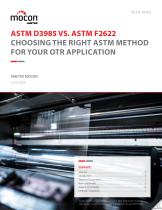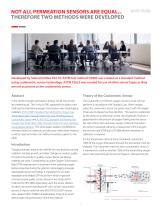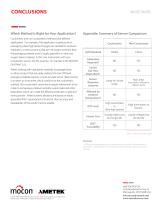 Website:
AMETEK MOCON
Website:
AMETEK MOCON
Group: AMETEK
Catalog excerpts

WHITE PAPER ASTM D3985 VS. ASTM F2622 CHOOSING THE RIGHT ASTM METHOD FOR YOUR OTR APPLICATION AMETEK MOCON June 2024 Content: Abstract. . . . . . . . . . . . . . . . . . . . . . . . . . . . . . . . . . . . . . . . . . . . . . . . . . . . . . . . . . . 2 Introduction. . . . . . . . . . . . . . . . . . . . . . . . . . . . . . . . . . . . . . . . . . . . . . . . . . . . . . . 2 Theory of Coulometric. . . . . . . . . . . . . . . . . . . . . . . . . . . . . . . . . . . . . . . . . . . . 2 Non-coulometric. . . . . . . . . . . . . . . . . . . . . . . . . . . . . . . . . . . . . . . . . . . . . . . . . . 3 Aspects to Consider. . . . . . . . . . . . . . . . . . . . . . . . . . . . . . . . . . . . . . . . . . . . . . . 4 Method Comparison. . . . . . . . . . . . . . . . . . . . . . . . . . . . . . . . . . . . . . . . . . . . . . 4 To get reliable permeation data of high or ultra-high barrier materials requires an accurate and repeatable test method such as ASTM D3985.
Open the catalog to page 1
NOT ALL PERMEATION SENSORS ARE EQUAL... THEREFORE TWO METHODS WERE DEVELOPED WHITE PAPER Developed by Subcommittee F02.10: ASTM test method D3985 was created as a standard method using coulometric sensor technology. ASTM F2622 was created for use of other sensor types as they are not as precise as the coulometric sensor. Theory of the Coulometric Sensor In the world of oxygen permeation testing, not all instruments are created equal. This is why ASTM1 approved two distinct test methods for determining oxygen transmission rates of packaging materials: ASTM D3985 Standard Test Method for...
Open the catalog to page 2
TRUE COULOMETRIC SENSORS DO NOT REQUIRE CALIBRATION method is considered an “intrinsic” standard that does not require calibration, it can be used as a reference method to verify the accuracy of non-coulometric OTR test results. barriers because the amount of oxygen received by the sensor is so small. Also, to ensure the total transmission rate is calculated accurately, the electrochemical sensor must make a comparison to a known amount of oxygen which makes the system calibration-dependent. When calibrating, it is important to use a material that has a similar OTR to the test material to...
Open the catalog to page 3
Which Method is Right for Your Application? Coulometric and non-coulometric methods have different applications. For example, if the application is produce/fruit packaging where high levels of oxygen are needed for products’ respiration, or other products that are not oxygen-sensitive, then the packaging material used is usually polyolefin or other low oxygen barrier material. In this case, instruments with noncoulometric sensors suit the purpose. An example is the MOCON OX-TRAN® 2/12. When working with high barrier materials to package foods or other products that are easily oxidized, the...
Open the catalog to page 4All AMETEK MOCON catalogs and technical brochures
-
Dansensor ISM-3
2 Pages
-
PERMATRAN-W Model 101 K
4 Pages
-
AQUATRAN 3/40
4 Pages
-
Dansensor MAP Check 3 Vacuum
2 Pages
-
Dansensor LeakMatic II
2 Pages
-
The ProSpect Advantage
2 Pages
-
Optimize Butter Production
3 Pages
-
Dansensor LeakPointer H20
2 Pages
-
PERMATRAN-C 4/30 Analyzer
4 Pages
-
OX-TRAN 2/48 Series
4 Pages
-
Dansensor Lippke VC1400
2 Pages
-
Toxic Gas Monitoring
4 Pages
-
Trace Gases In Ambient Air
4 Pages
-
Surface Logging
4 Pages
-
Impurities In Specialty Gas
4 Pages
-
Baseline VOC-TRAQ II
4 Pages
-
OX-TRAN 2/28 H
4 Pages
-
AQUATRAN 3/38 H
4 Pages
-
PERMATRAN-W® Model 101K
4 Pages
-
MOCON® BASELINE® PRODUCTS
2 Pages
-
PERMATRAN-C® Model 4/41
2 Pages
-
OX-TRAN Model 2/12 Series
2 Pages
-
OX-TRAN® Model 2/40 Series
4 Pages
-
OX-TRAN Model 2/22 Series
2 Pages
-
Oxygen and Water Vapor
4 Pages
-
MAP Gas Mixtures Poster
1 Pages
-
Dansensor ISM 3
2 Pages
-
PERMATRAN-W Model 3/34
2 Pages
-
BevAlert®
6 Pages
-
AQUATRAN® Model 3
2 Pages
Archived catalogs
-
PERMATRAN-W Model 3/61
4 Pages
-
PERMATRAN-W® Model 700
4 Pages
-
PERMATRAN-W® Model 398
2 Pages
-
OX-TRAN® Model 2/61
4 Pages
-
MultiCheck Series
4 Pages
-
OX-TRAN Model 2/61
4 Pages
-
OX-TRAN Model 702
4 Pages
-
OX-TRAN Model 2/10
2 Pages
-
piD-TECH® eVx
4 Pages
-
CheckPoint 3
2 Pages
































































































